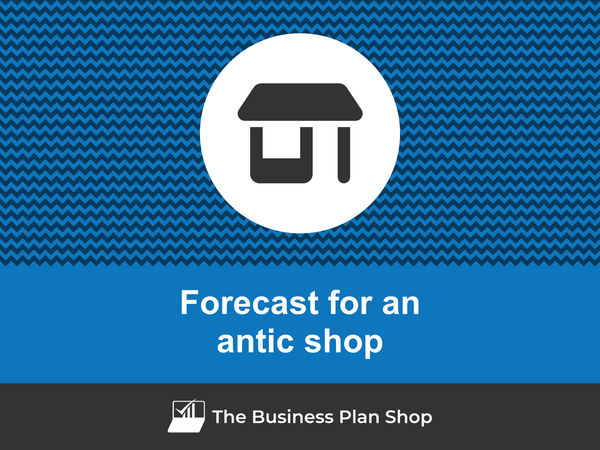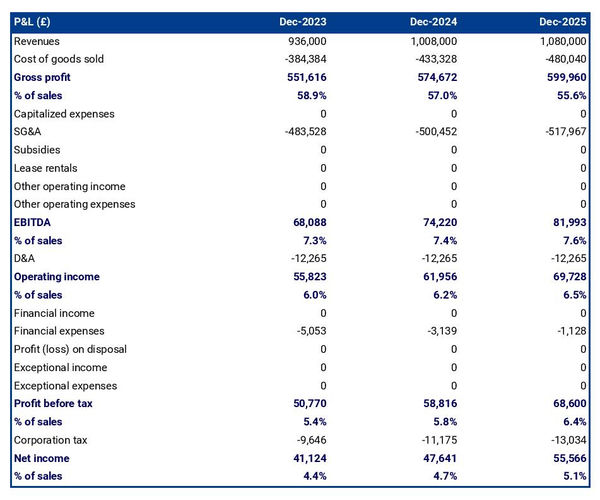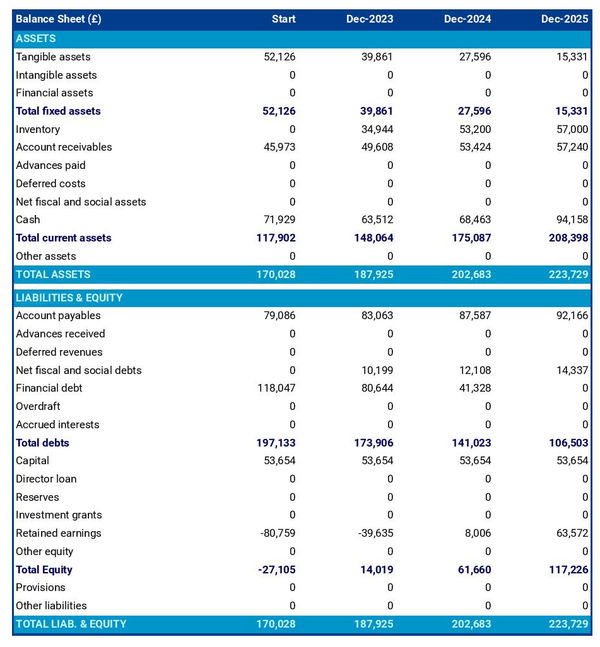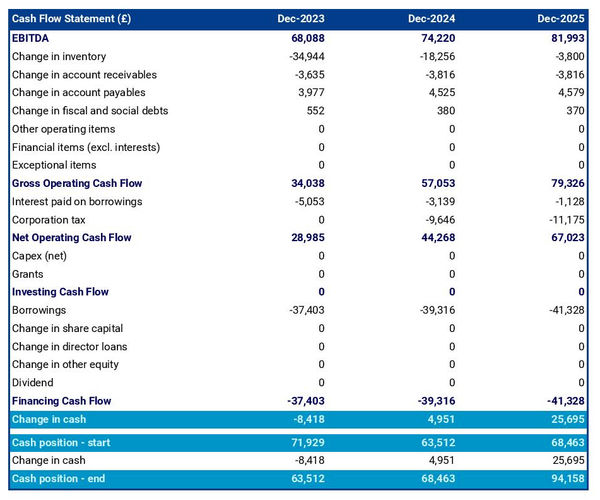How to create a financial forecast for an antic shop?

Developing and maintaining an up-to-date financial forecast for your antic shop is key in order to maintain visibility on your business’s future cash flows.
If you feel overwhelmed at the thought of putting together an antic shop financial forecast then don’t worry as this guide is here to help you.
We'll cover everything from: the main objectives of a financial forecast, the data you need to gather before starting, to the tables that compose it, and the tools that will help you create and maintain your forecast efficiently.
Let's get started!
Why create and maintain a financial forecast for an antic shop?
The financial projections for your antic shop act as a financial blueprint to guide its growth with confidence and ensure its long-term financial viability.
To create them, you will need to look at your business in detail - from sales to operating costs and investments - to assess how much profit it can generate in the years to come and what will be the associated cash flows.
During challenging market conditions, maintaining an up-to-date financial forecast enables early detection of potential financial shortfalls, allowing for timely adjustments or securing financing before facing a cash crisis.
Your antic shop's financial forecast will also prove invaluable when seeking financing. Banks and investors will undoubtedly request a thorough examination of your financial figures, making precision and presentation essential.
Need a solid financial forecast?
The Business Plan Shop does the maths for you. Simply enter your revenues, costs and investments. Click save and our online tool builds a three-way forecast for you instantly.

What information is used as input to build an antic shop financial forecast?
A antic shop's financial forecast is only as good as the inputs used to build it.
If you are creating (or updating) the forecast of an existing antic shop, then you mostly need your accounting information, key historical operating non-financial data, and your team’s input on what to expect for the coming years.
If you are building financial projections for an antic shop startup, you will need to have done your research and have a clear picture of your competitive environment and go-to-market strategy so that you can forecast sales accurately.
For a new venture, you will also need a precise list of the resources needed to keep the antic shop running on a day-to-day basis and a list of the equipment and expenditures required to start the business (more on that later).
Let's now take a closer look at the elements that make up your antic shop's financial forecast.
The sales forecast for an antic shop
The sales forecast, also called topline projection, is normally where you will start when building your antic shop financial forecast.
Creating a coherent sales projection boils down to estimating two key drivers:
- The average price
- The number of monthly transactions
To do this, you will need to rely on historical data (for an existing business), market research data (for both new and existing antic shops), and consider the elements below:
- The popularity of certain historical periods or events may drive demand for specific types of antiques, causing fluctuations in average price and number of monthly transactions.
- The availability of rare or unique items in the market may influence the average price and number of monthly transactions, as customers may be willing to pay a premium for these items.
- The economic climate and consumer spending habits can impact the purchasing power of customers, which may affect the average price and number of monthly transactions in the antique market.
- The reputation and expertise of the owner and staff may impact the trust and confidence of customers, leading to increased or decreased sales and average price of items.
- The location of the shop, such as being in a popular tourist destination or a highly affluent area, can influence the average price and number of monthly transactions, as these factors can attract a specific type of customer with varying budgets.
After the sales forecast comes the operating expenses budget, which we will now look into in more detail.
Need inspiration for your business plan?
The Business Plan Shop has dozens of business plan templates that you can use to get a clear idea of what a complete business plan looks like.

The operating expenses for an antic shop
The next step is to estimate the costs you’ll have to incur to operate your antic shop.
These will vary based on where your business is located, and its overall size (level of sales, personnel, etc.).
But your antic shop's operating expenses should normally include the following items:
- Staff costs: This includes wages, salaries, benefits, and any other costs associated with your employees. This may also include hiring and training expenses.
- Rent/Lease: As an antic shop, you will need a physical space to display and sell your items. This expense includes the rent or lease for your shop.
- Utilities: This includes expenses for electricity, water, gas, and other necessary utilities for your shop.
- Inventory: As an antic shop, you will need to purchase inventory to sell. This expense includes the cost of acquiring and maintaining your inventory.
- Marketing and Advertising: In order to attract customers to your shop, you will need to invest in marketing and advertising efforts. This may include social media ads, flyers, and other promotional materials.
- Accountancy Fees: As a business owner, you will need to keep track of your finances and file taxes. This expense includes the fees for hiring an accountant or bookkeeper to help you with these tasks.
- Insurance Costs: It is important to have insurance for your shop in case of any accidents or damages. This expense includes the cost of insurance premiums.
- Software Licences: In order to efficiently run your shop, you may need to invest in software such as inventory management or point-of-sale systems. This expense includes the cost of purchasing and renewing software licences.
- Banking Fees: This includes any fees associated with your business bank account, such as monthly maintenance fees or transaction fees.
- Repairs and Maintenance: As with any physical space, your shop will require regular maintenance and repairs. This expense includes the cost of fixing any damages or wear and tear.
- Cleaning Services: In order to maintain a clean and presentable shop, you may need to hire a cleaning service. This expense includes the cost of regular cleaning.
- Licences and Permits: Depending on your location, you may need to obtain licences and permits to operate your antic shop. This expense includes the cost of obtaining and renewing these permits.
- Credit Card Processing Fees: If you accept credit card payments, you will need to pay fees to the credit card processing company for each transaction. This expense includes those fees.
- Training and Development: It is important to invest in the growth and development of your employees. This expense includes the cost of training programs and workshops for your staff.
- Professional Memberships: As a business owner, it is beneficial to stay connected with industry professionals and organizations. This expense includes the cost of joining and renewing memberships to relevant associations.
This list is not exhaustive by any means, and will need to be tailored to your antic shop's specific circumstances.
What investments are needed to start or grow an antic shop?
Once you have an idea of how much sales you could achieve and what it will cost to run your antic shop, it is time to look into the equipment required to launch or expand the activity.
For an antic shop, capital expenditures and initial working capital items could include:
Again, this list will need to be adjusted according to the specificities of your antic shop.
Need a convincing business plan?
The Business Plan Shop makes it easy to create a financial forecast to assess the potential profitability of your projects, and write a business plan that’ll wow investors.

The financing plan of your antic shop
The next step in the creation of your financial forecast for your antic shop is to think about how you might finance your business.
You will have to assess how much capital will come from shareholders (equity) and how much can be secured through banks.
Bank loans will have to be modelled so that you can separate the interest expenses from the repayments of principal, and include all this data in your forecast.
Issuing share capital and obtaining a bank loan are two of the most common ways that entrepreneurs finance their businesses.
What tables compose the financial plan for an antic shop?
Now let's have a look at the main output tables of your antic shop's financial forecast.
The profit & loss forecast
The forecasted profit & loss statement will enable you to visualise your antic shop's expected growth and profitability over the next three to five years.

A financially viable P&L statement for an antic shop should normally show:
- Sales growing above inflation
- Stable or expanding (ideally) profit margins
- A net profit
This will of course depend on the stage of your business: a new venture might be loss-making until it reaches its breakeven point in year 2 or 3, for example.
The projected balance sheet
The projected balance sheet gives an overview of your antic shop's financial structure at the end of the financial year.
It is composed of three categories of items: assets, liabilities and equity:
- Assets: are what the business possesses and uses to produce cash flows. It includes resources such as cash, buildings, equipment, and accounts receivable (money owed by clients).
- Liabilities: are the debts of your antic shop. They include accounts payable (money owed to suppliers), taxes due and bank loans.
- Equity: is the combination of what has been invested by the business owners and the cumulative profits to date (which are called retained earnings). Equity is a proxy for the value of the owner's stake in the business.

The cash flow forecast
Your antic shop's cash flow forecast shows how much cash your business is expected to consume or generate in the years to come.

It is best practice to organise the cash flow forecast by nature to better explain where cash is used or generated by the antic shop:
- Operating cash flow: shows how much cash is generated by the operating activities
- Investing cash flow: shows how much will be invested in capital expenditure to maintain or expand the business
- Financing cash flow: shows if the business is raising new capital or repaying financiers (debt repayment, dividends)
Keeping an eye on (and regularly updating) your antic shop's cash flow forecast is key to ensuring that your business has sufficient liquidity to operate normally and to detect financing requirements as early as possible.
If you are trying to raise capital, you will normally be asked to provide a monthly cash flow forecast in your antic shop's financial plan - so that banks or investors can assess seasonal variation and ensure your business is appropriately capitalised.
Need a solid financial forecast?
The Business Plan Shop does the maths for you. Simply enter your revenues, costs and investments. Click save and our online tool builds a three-way forecast for you instantly.

Which tool should you use to create your antic shop's financial forecast?
Creating your antic shop's financial forecast may sound fairly daunting, but the good news is that there are several ways to go about it.
Using online financial forecasting software to build your antic shop's projections
The modern and easiest way is to use an online financial forecasting tool such as the one we offer at The Business Plan Shop.
There are several advantages to using specialised software:
- You can easily create your financial forecast by letting the software take care of the financial calculations for you without errors
- You have access to complete financial forecast templates
- You get a complete financial forecast ready to be sent to your bank or investors
- You can easily track your actual financial performance against your financial forecast, and recalibrate your forecast as the year goes by
- You can create scenarios to stress test your forecast's main assumptions
- You can easily update your forecast as time goes by to maintain visibility on future cash flows
- You have a friendly support team on standby to assist you when you are stuck
- It’s cost-efficient and much cheaper than using an accountant or consultant (see below)
If you are interested in this type of solution, you can try our projection software for free by signing up here.
Hiring a financial consultant or chartered accountant
Hiring a consultant or chartered accountant is also an efficient way to get a professional antic shop financial projection.
As you can imagine, this solution is much more expensive than using software. From experience, the creation of a simple financial forecast over three years (including a balance sheet, income statement, and cash flow statement) is likely to start around £700 or $1,000 excluding taxes.
The indicative estimate above, is for a small business, and a forecast done as a one-off. Using a financial consultant or accountant to track your actuals vs. forecast and to keep your financial forecast up to date on a monthly or quarterly basis will naturally cost a lot more.
If you choose this solution, make sure your service provider has first-hand experience in your industry, so that they may challenge your assumptions and offer insights (as opposed to just taking your figures at face value to create the forecast’s financial statements).
Why not use a spreadsheet such as Excel or Google Sheets to build your antic shop's financial forecast?
Creating an accurate and error-free antic shop financial forecast with a spreadsheet is very technical and requires a deep knowledge of accounting and an understanding of financial modelling.
Very few business owners are financially savvy enough to be able to build a forecast themselves on Excel without making mistakes.
Lenders and investors know this, which is why forecasts created on Excel by the business owner are often frowned upon.
Having numbers one can trust is key when it comes to financial forecasting and to that end using software is much safer.
Using financial forecasting software is also faster than using a spreadsheet, and, with the rise of artificial intelligence, software is also becoming smarter at helping us analyse the numbers to make smarter decisions.
Finally, like everything with spreadsheets, tracking actuals vs. forecasts and keeping your projections up to date as the year progresses is manual, tedious, and error-prone. Whereas financial projection software like The Business Plan Shop is built for this.
Need a convincing business plan?
The Business Plan Shop makes it easy to create a financial forecast to assess the potential profitability of your projects, and write a business plan that’ll wow investors.

Use our financial projection templates for inspiration
The Business Plan Shop has dozens of financial forecast templates available.
Our examples contain a complete business plan with a financial forecast and a written presentation of the company, the team, the strategy, and the medium-term objectives.
Whether you are just starting out or already have your own antic shop, looking at our financial forecast template is a good way to:
- Understand what a complete business plan should look like
- Understand how you should model financial items for your antic shop

Takeaways
- Having a financial forecast enables you to visualise the expected growth, profitability, and cash generation for your business over the next three to five years.
- Tracking actuals vs. forecast and keeping your financial projections up-to-date is the only way to get a view on what your antic shop future cash flows may look like.
- Using financial forecasting software is the mordern and easy way to create and maintain your forecasts.
This is the end of our guide on how to build the financial forecast for an antic shop, we hope you found it useful. Don't hesitate to contact us if you want to share your feedback or have any questions.
Need inspiration for your business plan?
The Business Plan Shop has dozens of business plan templates that you can use to get a clear idea of what a complete business plan looks like.

Also on The Business Plan Shop
Know someone who owns or is thinking of starting an antic shop? Share our forecasting guide with them!




